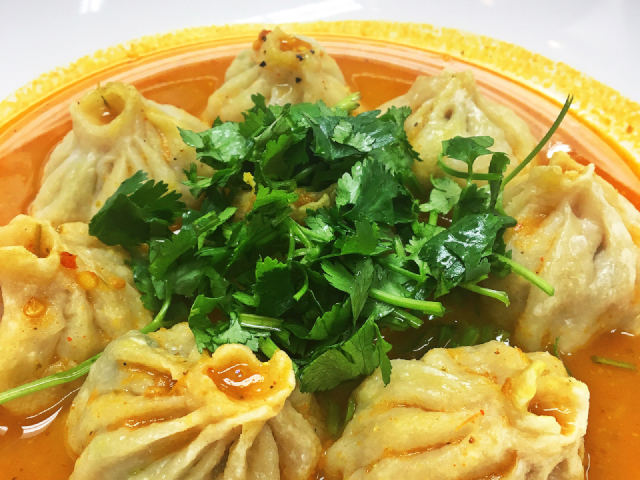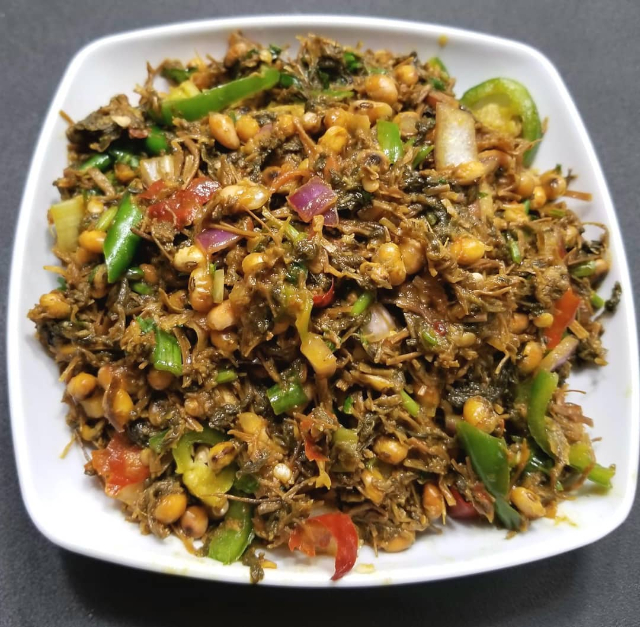It’s true that most western folks who visit Nepal are there on an expedition – to summit Everest. But while they’re waiting for their turn on the mountain, they discover that the tiny Himalayan nation has much of its own to offer at the table, along with dishes imported from its neighbours…
 Dal Bhat: Nepal’s national dish…
Dal Bhat: Nepal’s national dish…
If you go to Nepal looking for stereotyped dishes such as Yak Stew, forget it. Any Yaks they have are kept for milking. But you’re much more likely to find the shaggy multi-purpose beasts in neighbouring Tibet. The Nepalese prefer (Water) Buffalo milk.
The ‘snapshot’ overview of Nepalese cuisine is beautifully expressed by holidify.com: “Nepalese cuisine takes influence from its neighbours India, Tibet and China. [It] is supposed to be healthy and cooked in less fat. The common dishes involve soups, lean curries, vegetables, salads, lean meat, pickles, and curd. The ingredients include tomatoes, chillies, coriander, garlic and mustard oil.”
On our menu today
Dal Bhat: This is a platter, rather than a single dish. Centred on Rice and Lentils, accompanied by sides including meat, vegetables, curd (Juju Dhau; see ‘Sweets’, tomorrow), and pickles. The platter may also include Lentil Soup and/or Veggie or Chicken curry. This presentation is enjoyed across Nepal and is considered the national disyh.
Momos: You’ll immediately think of Chinese Bao dumplings when you first see these little round packets with their twisted tops. They’re usually filled with minced, veggies, lamb or chicken.

They’re cooked in the soup they’re meant to augment – often chicken. Here’s a rare dish, in that it’s been exported from Nepal to many of its neighbours. Momos are a rage, even in India.
Samosas: As if to ‘even the trade balance’, India long ago exported the Samosa to Nepal. If you’re not already a fan, Samosas are triangular, deep-fried, crispy packets of white flour pastry stuffed with many different fillings in India, but almost always with a mixture of mashed potatoes and spices. Red Chilies are traditionally featured. Nepalese Samosas are usually served with a sweet red chutney.
Dhido Thali: A favourite around the Nepalese countryside, this porridge is made from stone ground corn meal, buckwheat or millet flour and salt. A significant amount of salt.

It’s an every-day staple for the average family, and is usually topped by butter, and accompanied by vegetable curries, pickles, buttermilk and yoghurt (Juju Dhau). It’s so ubiquitous, you might say Dhido Thali is another national dish of Nepal.
Gorkhali Lamb Curry: Usually reserved for special occasions, this recipe features fall-apart lamb chunks or shreds in a complex sauce which includes more than a dozen spices and flavours.

It’s traditionally a very hot dish! Lamb chops or shoulder are first grilled and then simmered low and slow in a rich curry sauce.
Chatamari: Sometimes referred to as Nepalese Pizza (see photo, top of page), this dish is really composed of a thin, crispy, rice flour crèpe-like pancake topped with minced meat, eggs, onions, chilies and a lot of spices – predominantly coriander. This is another very hot (spicy) dish!
Thukpa: Thukpa can represent, for us, the whole family of Nepalese noodle dishes. It’s an all-purpose cold weather soup usually featuring veggies and, occasionally, hard-boiled eggs.

When there’s meat, it may be goat, lamb, chicken or (sometimes) yak. And This is one of the main soups where Momos are used. The noodles are an import from Chinese cuisine.
Gundruk: An oddity among Nepalese dishes, it’s based on pickled or fermented green, leafy veggies and cauliflower. Mustard and radish greens are primary to the basic pickled condiment.

Gundruk Ko Achar (photo directly above) is a common version of this dish, enhanced with onion, green chilies, tomatoes, garlic, ginger, mustard oil, fenugreek, turmeric, lemon, and salt, and served as a side.
And there’s lots more where that came from!
Tomorrow, we’ll survey Nepalese specialties, desserts and beverages – and suggest some great websites to start you on your extended Nepalese culinary journey!
~ Maggie J.

